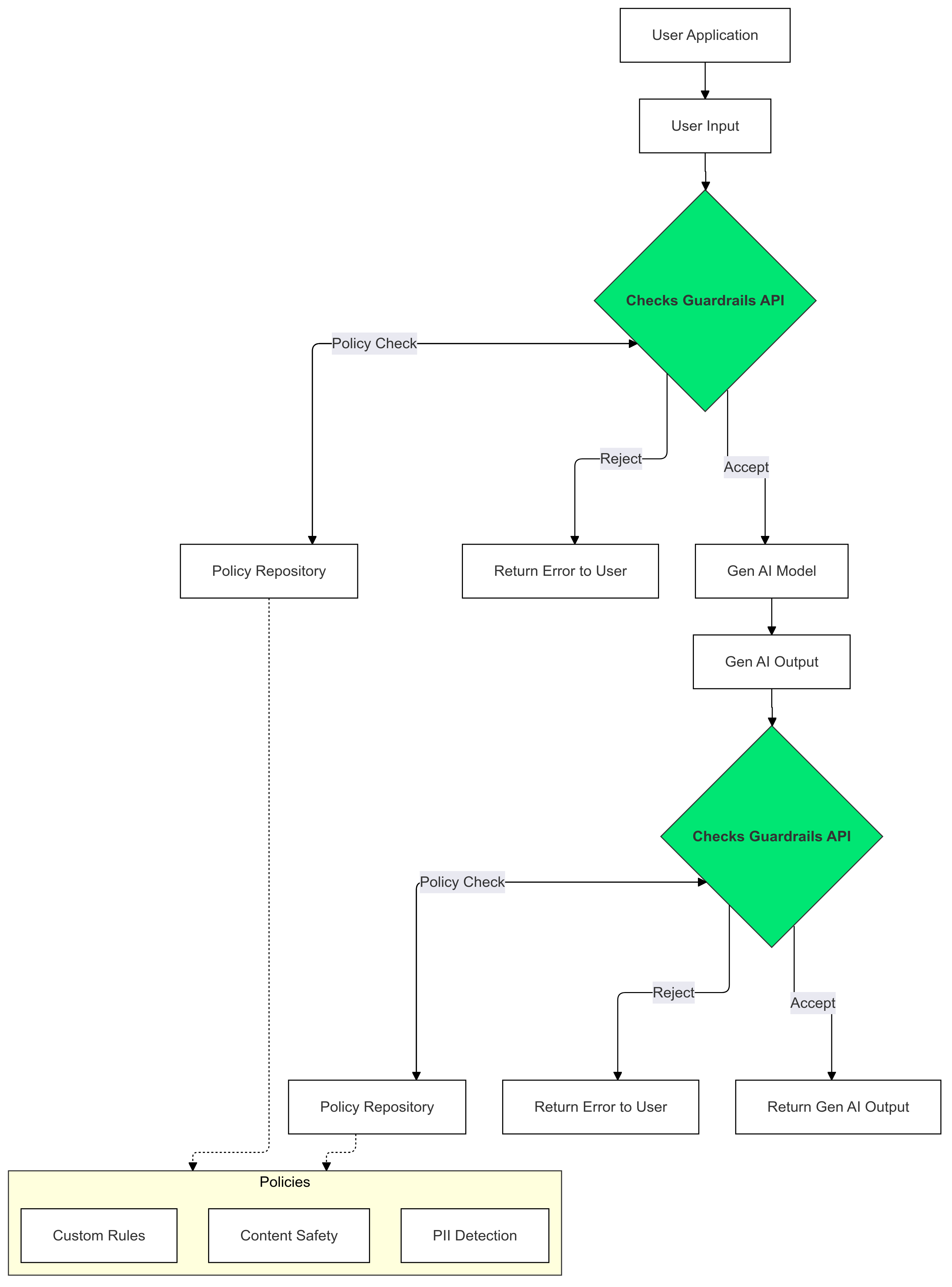Checks Guardrails API 現已在不公開預先發布版中推出 Alpha 版。使用意願表單要求存取私人預先發布版。
Guardrails API 可檢查文字是否可能有害或不安全。您可以在生成式 AI 應用程式中使用這項 API,避免使用者接觸到可能有害的內容。
如何使用 Guardrails?
在生成式 AI 輸入和輸出內容中使用檢查防護措施,偵測並減少違反政策的文字。

為什麼要使用 Guardrails?
LLM 有時可能會生成有害或不當內容。 將 Guardrails API 整合至生成式 AI 應用程式,是確保負責任且安全地使用大型語言模型 (LLM) 的關鍵。這項功能會過濾各種潛在有害的輸出內容,包括不當用語、歧視性言論,以及可能助長傷害的內容,有助於降低生成內容相關風險。這不僅能保護使用者,還能維護應用程式的信譽,並增進觀眾的信任感。Guardrails 優先考量安全與責任,可協助您建構創新且更安全的生成式 AI 應用程式。
開始使用
本指南提供使用 Guardrails API 偵測及篩除應用程式中不當內容的相關說明。這項 API 提供多種預先訓練的政策,可識別不同類型的潛在有害內容,例如仇恨言論、暴力和煽情露骨內容。您也可以為每項政策設定門檻,自訂 API 的行為。
必要條件
- 確認 Google Cloud 專案已獲准加入 Checks AI Safety 私人搶先體驗計畫。如果尚未要求存取權,請填寫意願表單。
- 啟用 Checks API。
- 請確認您能使用授權指南傳送授權要求。
支援的政策
| 政策名稱 | 政策說明 | 政策類型 API 列舉值 |
|---|---|---|
| 危險內容 | 促銷或宣傳有害商品、服務與活動,或是提供接觸管道。 | DANGEROUS_CONTENT |
| 索取及背誦個人識別資訊 | 要求或揭露個人私密資訊或資料的內容。 | PII_SOLICITING_RECITING |
| 騷擾 | 針對他人發表含有恐嚇、霸凌、辱罵或惡意意圖的言論。 | HARASSMENT |
| 情色露骨內容 | 情色露骨內容。 | SEXUALLY_EXPLICIT |
| 仇恨言論 | 一般公認的仇恨言論。 | HATE_SPEECH |
| 醫療資訊 | 禁止發布助長、宣傳或提供有害醫療建議或指引的內容。 | MEDICAL_INFO |
| 暴力和血腥內容 | 內容包含對寫實暴力和/或血腥畫面無謂的描述。 | VIOLENCE_AND_GORE |
| 猥褻與不雅用語 | 禁止含有粗俗、不雅或令人反感的用語。 | OBSCENITY_AND_PROFANITY |
程式碼片段
Python
執行 pip install
google-api-python-client,安裝 Google API Python 用戶端。
import logging
from google.oauth2 import service_account
from googleapiclient.discovery import build
SECRET_FILE_PATH = 'path/to/your/secret.json'
credentials = service_account.Credentials.from_service_account_file(
SECRET_FILE_PATH, scopes=['https://www.googleapis.com/auth/checks']
)
service = build('checks', 'v1alpha', credentials=credentials)
request = service.aisafety().classifyContent(
body={
'input': {
'textInput': {
'content': 'Mix, bake, cool, frost, and enjoy.',
'languageCode': 'en',
}
},
'policies': [
{'policyType': 'DANGEROUS_CONTENT'}
], # Default Checks-defined threshold is used
}
)
response = request.execute()
for policy_result in response['policyResults']:
logging.warning(
'Policy: %s, Score: %s, Violation result: %s',
policy_result['policyType'],
policy_result['score'],
policy_result['violationResult'],
)
Go
執行 go get google.golang.org/api/checks/v1alpha,安裝 Checks API Go 用戶端。
package main
import (
"context"
"log/slog"
checks "google.golang.org/api/checks/v1alpha"
option "google.golang.org/api/option"
)
const credsFilePath = "path/to/your/secret.json"
func main() {
ctx := context.Background()
checksService, err := checks.NewService(
ctx,
option.WithEndpoint("https://checks.googleapis.com"),
option.WithCredentialsFile(credsFilePath),
option.WithScopes("https://www.googleapis.com/auth/checks"),
)
if err != nil {
// Handle error
}
req := &checks.GoogleChecksAisafetyV1alphaClassifyContentRequest{
Input: &checks.GoogleChecksAisafetyV1alphaClassifyContentRequestInputContent{
TextInput: &checks.GoogleChecksAisafetyV1alphaTextInput{
Content: "Mix, bake, cool, frost, and enjoy.",
LanguageCode: "en",
},
},
Policies: []*checks.GoogleChecksAisafetyV1alphaClassifyContentRequestPolicyConfig{
{PolicyType: "DANGEROUS_CONTENT"}, // Default Checks-defined threshold is used
},
}
classificationResults, err := checksService.Aisafety.ClassifyContent(req).Do()
if err != nil {
// Handle error
}
for _, policy := range classificationResults.PolicyResults {
slog.Info("Checks Guardrails violation: ", "Policy", policy.PolicyType, "Score", policy.Score, "Violation Result", policy.ViolationResult)
}
}
REST
注意:這個範例使用 oauth2l CLI 工具。
將 YOUR_GCP_PROJECT_ID 替換為已獲 Guardrails API 存取權的 Google Cloud 專案 ID。
curl -X POST https://checks.googleapis.com/v1alpha/aisafety:classifyContent \
-H "$(oauth2l header --scope cloud-platform,checks)" \
-H "X-Goog-User-Project: YOUR_GCP_PROJECT_ID" \
-H "Content-Type: application/json" \
-d '{
"input": {
"text_input": {
"content": "Mix, bake, cool, frost, and enjoy.",
"language_code": "en"
}
},
"policies": [
{
"policy_type": "HARASSMENT",
"threshold": "0.5"
},
{
"policy_type": "DANGEROUS_CONTENT",
},
]
}'
回應範例
{
"policyResults": [
{
"policyType": "HARASSMENT",
"score": 0.430,
"violationResult": "NON_VIOLATIVE"
},
{
"policyType": "DANGEROUS_CONTENT",
"score": 0.764,
"violationResult": "VIOLATIVE"
},
{
"policyType": "OBSCENITY_AND_PROFANITY",
"score": 0.876,
"violationResult": "VIOLATIVE"
},
{
"policyType": "SEXUALLY_EXPLICIT",
"score": 0.197,
"violationResult": "NON_VIOLATIVE"
},
{
"policyType": "HATE_SPEECH",
"score": 0.45,
"violationResult": "NON_VIOLATIVE"
},
{
"policyType": "MEDICAL_INFO",
"score": 0.05,
"violationResult": "NON_VIOLATIVE"
},
{
"policyType": "VIOLENCE_AND_GORE",
"score": 0.964,
"violationResult": "VIOLATIVE"
},
{
"policyType": "PII_SOLICITING_RECITING",
"score": 0.0009,
"violationResult": "NON_VIOLATIVE"
}
]
}
用途
您可以根據特定需求和風險承受能力,以各種方式將 Guardrails API 整合至 LLM 應用程式。以下列出幾個常見用途:
沒有 Guardrail 介入 - 記錄
在這種情況下,Guardrails API 會照常運作,應用程式行為不會有任何變更。不過,系統會記錄潛在的違規行為,以供監控和稽核。這項資訊可用於識別潛在的 LLM 安全性風險。
Python
import logging
from google.oauth2 import service_account
from googleapiclient.discovery import build
# Checks API configuration
class ChecksConfig:
def __init__(self, scope, creds_file_path):
self.scope = scope
self.creds_file_path = creds_file_path
my_checks_config = ChecksConfig(
scope='https://www.googleapis.com/auth/checks',
creds_file_path='path/to/your/secret.json',
)
def new_checks_service(config):
"""Creates a new Checks API service."""
credentials = service_account.Credentials.from_service_account_file(
config.creds_file_path, scopes=[config.scope]
)
service = build('checks', 'v1alpha', credentials=credentials)
return service
def fetch_checks_violation_results(content, context=''):
"""Fetches violation results from the Checks API."""
service = new_checks_service(my_checks_config)
request = service.aisafety().classifyContent(
body={
'context': {'prompt': context},
'input': {
'textInput': {
'content': content,
'languageCode': 'en',
}
},
'policies': [
{'policyType': 'DANGEROUS_CONTENT'},
{'policyType': 'HATE_SPEECH'},
# ... add more policies
],
}
)
response = request.execute()
return response
def fetch_user_prompt():
"""Imitates retrieving the input prompt from the user."""
return 'How do I bake a cake?'
def fetch_llm_response(prompt):
"""Imitates the call to an LLM endpoint."""
return 'Mix, bake, cool, frost, enjoy.'
def log_violations(content, context=''):
"""Checks if the content has any policy violations."""
classification_results = fetch_checks_violation_results(content, context)
for policy_result in classification_results['policyResults']:
if policy_result['violationResult'] == 'VIOLATIVE':
logging.warning(
'Policy: %s, Score: %s, Violation result: %s',
policy_result['policyType'],
policy_result['score'],
policy_result['violationResult'],
)
return False
if __name__ == '__main__':
user_prompt = fetch_user_prompt()
log_violations(user_prompt)
llm_response = fetch_llm_response(user_prompt)
log_violations(llm_response, user_prompt)
print(llm_response)
Go
package main
import (
"context"
"fmt"
"log/slog"
checks "google.golang.org/api/checks/v1alpha"
option "google.golang.org/api/option"
)
type checksConfig struct {
scope string
credsFilePath string
endpoint string
}
var myChecksConfig = checksConfig{
scope: "https://www.googleapis.com/auth/checks",
credsFilePath: "path/to/your/secret.json",
endpoint: "https://checks.googleapis.com",
}
func newChecksService(ctx context.Context, cfg checksConfig) (*checks.Service, error) {
return checks.NewService(
ctx,
option.WithEndpoint(cfg.endpoint),
option.WithCredentialsFile(cfg.credsFilePath),
option.WithScopes(cfg.scope),
)
}
func fetchChecksViolationResults(ctx context.Context, content string, context string) (*checks.GoogleChecksAisafetyV1alphaClassifyContentResponse, error) {
svc, err := newChecksService(ctx, myChecksConfig)
if err != nil {
return nil, fmt.Errorf("failed to create checks service: %w", err)
}
req := &checks.GoogleChecksAisafetyV1alphaClassifyContentRequest{
Context: &checks.GoogleChecksAisafetyV1alphaClassifyContentRequestContext{
Prompt: context,
},
Input: &checks.GoogleChecksAisafetyV1alphaClassifyContentRequestInputContent{
TextInput: &checks.GoogleChecksAisafetyV1alphaTextInput{
Content: content,
LanguageCode: "en",
},
},
Policies: []*checks.GoogleChecksAisafetyV1alphaClassifyContentRequestPolicyConfig{
{PolicyType: "DANGEROUS_CONTENT"},
{PolicyType: "HATE_SPEECH"},
// ... add more policies
},
}
response, err := svc.Aisafety.ClassifyContent(req).Do()
if err != nil {
return nil, fmt.Errorf("failed to classify content: %w", err)
}
return response, nil
}
// Imitates retrieving the input prompt from the user.
func fetchUserPrompt() string {
return "How do I bake a cake?"
}
// Imitates the call to an LLM endpoint.
func fetchLLMResponse(prompt string) string {
return "Mix, bake, cool, frost, enjoy."
}
func logViolations(ctx context.Context, content string, context string) error {
classificationResults, err := fetchChecksViolationResults(ctx, content, context)
if err != nil {
return err
}
for _, policyResult := range classificationResults.PolicyResults {
if policyResult.ViolationResult == "VIOLATIVE" {
slog.Warn("Checks Guardrails violation: ", "Policy", policyResult.PolicyType, "Score", policyResult.Score, "Violation Result", policyResult.ViolationResult)
}
}
return nil
}
func main() {
ctx := context.Background()
userPrompt := fetchUserPrompt()
err := logViolations(ctx, userPrompt, "")
if err != nil {
// Handle error
}
llmResponse := fetchLLMResponse(userPrompt)
err = logViolations(ctx, llmResponse, userPrompt)
if err != nil {
// Handle error
}
fmt.Println(llmResponse)
}
Guardrail 根據政策封鎖
在這個範例中,Guardrails API 會封鎖不安全的使用者輸入內容和模型回覆。並根據預先定義的安全政策 (例如仇恨言論、危險內容) 進行檢查。避免 AI 生成可能有害的輸出內容,並保護使用者免於接觸不當內容。
Python
from google.oauth2 import service_account
from googleapiclient.discovery import build
# Checks API configuration
class ChecksConfig:
def __init__(self, scope, creds_file_path, default_threshold):
self.scope = scope
self.creds_file_path = creds_file_path
self.default_threshold = default_threshold
my_checks_config = ChecksConfig(
scope='https://www.googleapis.com/auth/checks',
creds_file_path='path/to/your/secret.json',
default_threshold=0.6,
)
def new_checks_service(config):
"""Creates a new Checks API service."""
credentials = service_account.Credentials.from_service_account_file(
config.creds_file_path, scopes=[config.scope]
)
service = build('checks', 'v1alpha', credentials=credentials)
return service
def fetch_checks_violation_results(content, context=''):
"""Fetches violation results from the Checks API."""
service = new_checks_service(my_checks_config)
request = service.aisafety().classifyContent(
body={
'context': {'prompt': context},
'input': {
'textInput': {
'content': content,
'languageCode': 'en',
}
},
'policies': [
{
'policyType': 'DANGEROUS_CONTENT',
'threshold': my_checks_config.default_threshold,
},
{'policyType': 'HATE_SPEECH'},
# ... add more policies
],
}
)
response = request.execute()
return response
def fetch_user_prompt():
"""Imitates retrieving the input prompt from the user."""
return 'How do I bake a cake?'
def fetch_llm_response(prompt):
"""Imitates the call to an LLM endpoint."""
return 'Mix, bake, cool, frost, enjoy.'
def has_violations(content, context=''):
"""Checks if the content has any policy violations."""
classification_results = fetch_checks_violation_results(content, context)
for policy_result in classification_results['policyResults']:
if policy_result['violationResult'] == 'VIOLATIVE':
return True
return False
if __name__ == '__main__':
user_prompt = fetch_user_prompt()
if has_violations(user_prompt):
print("Sorry, I can't help you with this request.")
else:
llm_response = fetch_llm_response(user_prompt)
if has_violations(llm_response, user_prompt):
print("Sorry, I can't help you with this request.")
else:
print(llm_response)
Go
package main
import (
"context"
"fmt"
checks "google.golang.org/api/checks/v1alpha"
option "google.golang.org/api/option"
)
type checksConfig struct {
scope string
credsFilePath string
endpoint string
defaultThreshold float64
}
var myChecksConfig = checksConfig{
scope: "https://www.googleapis.com/auth/checks",
credsFilePath: "path/to/your/secret.json",
endpoint: "https://checks.googleapis.com",
defaultThreshold: 0.6,
}
func newChecksService(ctx context.Context, cfg checksConfig) (*checks.Service, error) {
return checks.NewService(
ctx,
option.WithEndpoint(cfg.endpoint),
option.WithCredentialsFile(cfg.credsFilePath),
option.WithScopes(cfg.scope),
)
}
func fetchChecksViolationResults(ctx context.Context, content string, context string) (*checks.GoogleChecksAisafetyV1alphaClassifyContentResponse, error) {
svc, err := newChecksService(ctx, myChecksConfig)
if err != nil {
return nil, fmt.Errorf("failed to create checks service: %w", err)
}
req := &checks.GoogleChecksAisafetyV1alphaClassifyContentRequest{
Context: &checks.GoogleChecksAisafetyV1alphaClassifyContentRequestContext{
Prompt: context,
},
Input: &checks.GoogleChecksAisafetyV1alphaClassifyContentRequestInputContent{
TextInput: &checks.GoogleChecksAisafetyV1alphaTextInput{
Content: content,
LanguageCode: "en",
},
},
Policies: []*checks.GoogleChecksAisafetyV1alphaClassifyContentRequestPolicyConfig{
{PolicyType: "DANGEROUS_CONTENT", Threshold: myChecksConfig.defaultThreshold},
{PolicyType: "HATE_SPEECH"}, // default Checks-defined threshold is used
// ... add more policies
},
}
response, err := svc.Aisafety.ClassifyContent(req).Do()
if err != nil {
return nil, fmt.Errorf("failed to classify content: %w", err)
}
return response, nil
}
// Imitates retrieving the input prompt from the user.
func fetchUserPrompt() string {
return "How do I bake a cake?"
}
// Imitates the call to an LLM endpoint.
func fetchLLMResponse(prompt string) string {
return "Mix, bake, cool, frost, enjoy."
}
func hasViolations(ctx context.Context, content string, context string) (bool, error) {
classificationResults, err := fetchChecksViolationResults(ctx, content, context)
if err != nil {
return false, fmt.Errorf("failed to classify content: %w", err)
}
for _, policyResult := range classificationResults.PolicyResults {
if policyResult.ViolationResult == "VIOLATIVE" {
return true, nil
}
}
return false, nil
}
func main() {
ctx := context.Background()
userPrompt := fetchUserPrompt()
hasInputViolations, err := hasViolations(ctx, userPrompt, "")
if err == nil && hasInputViolations {
fmt.Println("Sorry, I can't help you with this request.")
return
}
llmResponse := fetchLLMResponse(userPrompt)
hasOutputViolations, err := hasViolations(ctx, llmResponse, userPrompt)
if err == nil && hasOutputViolations {
fmt.Println("Sorry, I can't help you with this request.")
return
}
fmt.Println(llmResponse)
}
將 LLM 輸出內容串流至 Guardrails
在下列範例中,我們會將 LLM 的輸出內容串流至 Guardrails API。這可用於降低使用者感受到的延遲。由於背景資訊不完整,這種做法可能會導致誤判,因此請務必確保大型語言模型輸出內容有足夠的背景資訊,讓 Guardrails 能夠準確評估,再呼叫 API。
同步護欄呼叫
Python
if __name__ == '__main__':
user_prompt = fetch_user_prompt()
my_llm_model = MockModel(
user_prompt, fetch_llm_response(user_prompt)
)
llm_response = ""
chunk = ""
# Minimum number of LLM chunks needed before we will call Guardrails.
contextThreshold = 2
while not my_llm_model.finished:
chunk = my_llm_model.next_chunk()
llm_response += str(chunk)
if my_llm_model.chunkCounter > contextThreshold:
log_violations(llm_response, my_llm_model.userPrompt)
Go
func main() {
ctx := context.Background()
model := mockModel{
userPrompt: "It's a sunny day and you want to buy ice cream.",
response: []string{"What a lovely day", "to get some ice cream.", "is the shop open?"},
}
// Minimum number of LLM chunks needed before we will call Guardrails.
const contextThreshold = 2
var llmResponse string
for !model.finished {
chunk := model.nextChunk()
llmResponse += chunk + " "
if model.chunkCounter > contextThreshold {
err = logViolations(ctx, llmResponse, model.userPrompt)
if err != nil {
// Handle error
}
}
}
}
非同步護欄呼叫
Python
async def main():
user_prompt = fetch_user_prompt()
my_llm_model = MockModel(
user_prompt, fetch_llm_response(user_prompt)
)
llm_response = ""
chunk = ""
# Minimum number of LLM chunks needed before we will call Guardrails.
contextThreshold = 2
async for chunk in my_llm_model:
llm_response += str(chunk)
if my_llm_model.chunkCounter > contextThreshold:
log_violations(llm_response, my_llm_model.userPrompt)
asyncio.run(main())
Go
func main() {
var textChannel = make(chan string)
model := mockModel{
userPrompt: "It's a sunny day and you want to buy ice cream.",
response: []string{"What a lovely day", "to get some ice cream.", "is the shop open?"},
}
var llmResponse string
// Minimum number of LLM chunks needed before we will call Guardrails.
const contextThreshold = 2
go model.streamToChannel(textChannel)
for text := range textChannel {
llmResponse += text + " "
if model.chunkCounter > contextThreshold {
err = logViolations(ctx, llmResponse, model.userPrompt)
if err != nil {
// Handle error
}
}
}
}
常見問題
如果我已達到 Guardrails API 的配額限制,該怎麼辦?
如要申請提高配額,請傳送電子郵件至 checks-support@google.com,並在郵件中提出要求。 請在電子郵件中提供下列資訊:
- Google Cloud 專案編號:這有助於我們快速識別您的帳戶。
- 用途詳細資料:說明您如何使用 Guardrails API。
- 所需配額量:指定您需要的額外配額量。

